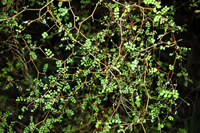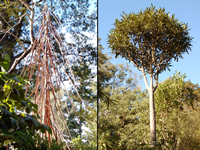Background
 In the past couple of decades, recognition of the ecological roles played by large extinct herbivores has become an important part of understanding how modern ecosystems function. The significance of these lost animals was first brought to the forefront of scientific thinking in 1984 by Daniel Janzen and Paul Martin who published a paper in Science describing a range of trees from Central America that produced large fruits, which fell to the ground at the base of the trees before rotting. Janzen and Martin suggested that these fruit had evolved to be dispersed by large, now-extinct animals, including the elephant-like gomphotheres. In the absence of these large animals, the trees no longer had any way to disperse their seeds across the landscape.
In the past couple of decades, recognition of the ecological roles played by large extinct herbivores has become an important part of understanding how modern ecosystems function. The significance of these lost animals was first brought to the forefront of scientific thinking in 1984 by Daniel Janzen and Paul Martin who published a paper in Science describing a range of trees from Central America that produced large fruits, which fell to the ground at the base of the trees before rotting. Janzen and Martin suggested that these fruit had evolved to be dispersed by large, now-extinct animals, including the elephant-like gomphotheres. In the absence of these large animals, the trees no longer had any way to disperse their seeds across the landscape.
Since then, a wide range of plant dispersal mechanisms and growth habits have been attributed to extinct megafauna. In New Zealand, many distinctive features of our flora have been attributed to coevolution with large browsing birds (moa). These include:
- Divarication or ‘wire plant syndrome’: Thin, fibrous, intertwined or tangled branches occur in many New Zealand shrubs and trees, and have been shown experimentally to significantly reduce browsing offtake by modern ratites (e.g. emus, ostriches). The ‘wire plant syndrome’ is also widespread in the flora of Madagascar, which was once home to the now-extinct herbivorous elephant bird.
- Heteroblasty: A range of New Zealand trees have juvenile stages (i.e. within reach of a hungry moa) with divaricating branches or low-nutrient, spiky foliage. The foliage then changes to a different form when the tree reaches a certain height.
- Mimicry or camoflauge: Some plants in New Zealand forests blend in very well with the background vegetation, or have seedlings that are difficult to see against the leaf litter. Others appear very similar to completely unrelated taxa that have distasteful or toxic compounds in their leaves.
- Spines: Several New Zealand plants have spines, which may have assisted with reducing the levels of herbivory they experienced. However, spines are a more effective defense against mammals, and need to be quite long to be effective against browsing birds.
 Several ideas have also been put forth about how New Zealand’s vegetation may have responded to the extinction of these birds, the most prominent being the ‘podocarp-regeneration gap’. Originally considered to be due to climate change, bird extinctions were first proposed as an explanation by ecologist Peter Wardle in the 1970s. The idea was that when moa were roaming the landscape, broadleaved shrubs was mostly restricted to sites inaccessible to the birds, such as steep rock faces. Following the extinction of the moa there was several hundred years during which there was severely reduced herbivory. The broadleaved shrubs dispersed back into the forest understoreys where they flourished, and prevented regeneration of podocarps by shading of seedlings. If true, then the dense forest understoreys that greeted the first European botanists to New Zealand, and which are often held as ideal conservation goals, may be an artefact of the bird extinctions and therefore a completely unnatural situation. To go one step further, some have even suggested that modern forests with introduced deer and goats may in fact be more similar to the prehuman forests of New Zealand than those where these browsing mammals have been removed. Recent research has shown this is unlikely, as moa and deer are likely to have had quite different diets and effects on plants. However, the question as to how similar vegetation communities were with moa and deer remains without a satisfactory answer. By using a combination of dung-fungi spores and pollen we hope to shed some light on this question.
Several ideas have also been put forth about how New Zealand’s vegetation may have responded to the extinction of these birds, the most prominent being the ‘podocarp-regeneration gap’. Originally considered to be due to climate change, bird extinctions were first proposed as an explanation by ecologist Peter Wardle in the 1970s. The idea was that when moa were roaming the landscape, broadleaved shrubs was mostly restricted to sites inaccessible to the birds, such as steep rock faces. Following the extinction of the moa there was several hundred years during which there was severely reduced herbivory. The broadleaved shrubs dispersed back into the forest understoreys where they flourished, and prevented regeneration of podocarps by shading of seedlings. If true, then the dense forest understoreys that greeted the first European botanists to New Zealand, and which are often held as ideal conservation goals, may be an artefact of the bird extinctions and therefore a completely unnatural situation. To go one step further, some have even suggested that modern forests with introduced deer and goats may in fact be more similar to the prehuman forests of New Zealand than those where these browsing mammals have been removed. Recent research has shown this is unlikely, as moa and deer are likely to have had quite different diets and effects on plants. However, the question as to how similar vegetation communities were with moa and deer remains without a satisfactory answer. By using a combination of dung-fungi spores and pollen we hope to shed some light on this question.
An important question underlying all this is 'what did moa actually eat?' The first mention of moa feeding did not appear in scientific literature until about 36 years after the first moa bone had been discovered. In 1872 the eminent scientist Julius Von Haast wrote that moa:
“must have inhabited the open country where such existed, and not the forested regions, where not only innumerable impediments to locomotion would have stood in their way, but where they also would probably have found little food suitable to them…Moreover, I have little doubt, that the different species of Dinornis, like those of Apteryx, were omnivorous.”
In 1892 Henry Forbes reported seeing preserved gizzard content amongst moa bones excavated from Enfield Swamp in North Otago, and commented that they consisted of: 'More or less triturated grass mingled with crop stones'. In the same year, Augustus Hamilton reported the discovery of moa gizzard content eroding out of peat on Swampy Summit near Dunedin, which included short twigs and seeds of the shrubs Coprosma and Leucopogon. Despite this observation, the view that moa were largely grazers would remain pervasive for nearly a century afterwards. In his book Mystery of the moa; written in 1931, Thomas Buick stated that moa 'browsed upon the hillside grasses as cattle do, and devoured leaves and berries when it could reach them'. The idea that moa were open country birds, grazing in large herds on extensive grasslands, would have no doubt been fostered by the abundance of moa bones found scattered on the ground surface in grasslands during the early days of European settlement. It was likely that these grasslands were believed to be intact, natural vegetation communities, when in fact they were the result of anthropogenic burning and loss of the natural woody vegetation.
Further evidence for moa diet came in the 20th century. In a revelatory paper published in 1981, Colin Burrows and colleagues examined samples of moa gizzard content collected during excavations at Pyramid Valley Swamp in North Canterbury, and Scaife’s Lagoon in West Otago. In contrast to the view of moa diet at the time, they showed the samples were dominated by twigs, leaves and seeds of forest trees and shrubs, suggesting that at least some moa species were in fact browsers and not just grazers. Evidence from browsing was also found by Mark Horrocks and colleagues in 2004 when they examined several coprolites believed to be from the upland moa (Megalapteryx didinus). In the past 10 years, the discovery of several new rockshelters and cave sites with moa coprolites has allowed the question of moa diet to be revisited. Also, coprolites of other extinct birds have provided a way of finding out what these species ate, and what role they may have had in the prehuman ecology of New Zealand. In particular, the advent of ancient DNA techniques has provided a way of identifying coprolites, and thus examining dietary differences between species. A preliminary study published in Quaternary Science Reviews in December 2008 confirmed that grazing of herbs and low shrubs was indeed a major part of moa diet in certain habitat types. In addition, potential ecological relationships were identified between moa and certain types of currently rare and endangered herbs. The study highlighted the need for further study on the diets of New Zealand’s extinct birds, which would have significant implications for understanding the prehuman ecosystems of New Zealand, anachronistic evolutionary relationships in the New Zealand flora, and conservation of certain rare and endangered plants.
